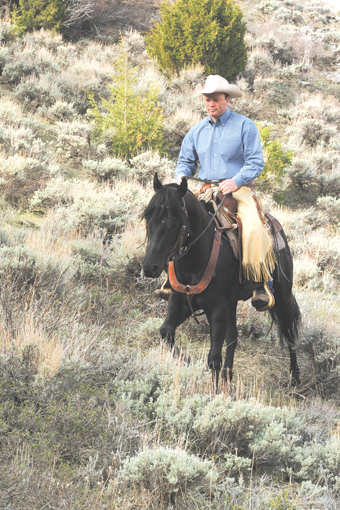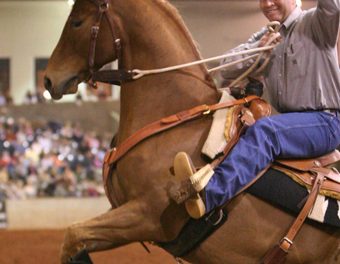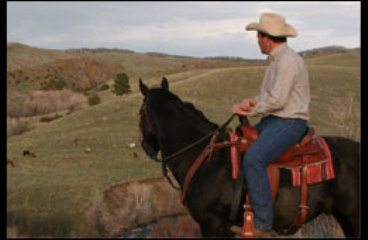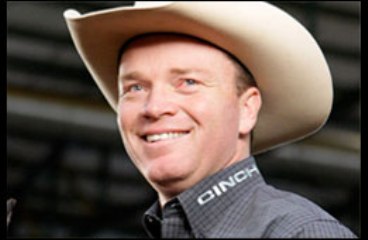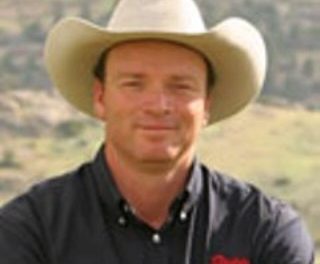 This month, we will cover five exercises that will help you to gain control of your horse’s shoulders. Whether you want to compete doing spins and rollbacks or working cattle, or you just want to have a nice ride down the trail, having control of your horse’s shoulders will make your ride safer and more fun.
This month, we will cover five exercises that will help you to gain control of your horse’s shoulders. Whether you want to compete doing spins and rollbacks or working cattle, or you just want to have a nice ride down the trail, having control of your horse’s shoulders will make your ride safer and more fun.
For these exercises you will need your horse saddled and bridled, and you will need a fence you can work along. Since these are advanced exercises, it is assumed that your horse is broke to ride, knows how to move off your leg, and knows how to soften in the bridle.
The first exercise is to teach your horse that the inside rein can control the movement of his outside shoulder. To start, work along a fence line. Tip your horse’s nose slightly in towards the fence. At the same time, think about moving his outside shoulder away from the fence. You will be laying your outside leg on as you move your horse’s shoulder, but don’t think about your leg too much. If you are thinking about where you want that shoulder to go, and looking where you want to go, your leg will naturally fall into the correct position. When your horse takes a step out with his shoulder, have him return to follow his nose for a few steps and then release him. When I say follow his nose, I mean that you tipped his nose in to the fence and asked him to step his shoulders away, so he was no longer moving in the direction his nose was pointing, and before you release him I want you to tip his nose away from the fence and have him take a few steps in the same direction his nose is pointing. It is VERY important to always return your horse to following his nose as the finish of each of these shoulder exercises. If you don’t, you can create a horse that runs away through his shoulders and lose your basic steering. Once your horse will consistently move either shoulder out when you pick up the inside rein, you are ready to move on to the next exercise.
In the second exercise, you will move off the fence and on to a circle, and you will add your second rein to avoid over bending your horse. Put your horse on a 10-15’ circle, and make sure it is a good consistent round circle. Pick up on both reins and get your horse soft in the bridle. You are going to ask your horse to step out with his shoulder just like you did in the first exercise, but now you are going to ask for bigger steps when he steps out. Your outside rein will stop his forward motion, but your body will tell him to keep going, and his opening will be to take that shoulder out.
This exercise gives you a lot of additional shoulder control, and is the foundation for a reverse arc circle. Ride on your circle, make sure it is a correct circle and your horse is bent slightly to the inside, then change the bend so his nose is tipped slightly to the outside of the circle, but think about keeping his feet on the same circle. Before you release him, make sure you have him follow his nose for a few steps. Don’t ask for a complete reverse arc circle at first. Just get a step or two and build on that gradually until you can make a full circle in a nice reverse arc. Once you can do that, you are ready to move on to the third exercise.
In the third exercise, I ride figure 8’s, one loop reverse arc, then next with my horse following his nose. This really smoothes out the transitions from a regular circle to a reverse arc circle and back. Your horse should keep his nose soft and level as you change his bend and change directions. When this is going well you can move on to the next exercise.
In the first exercise, we taught our horse to connect the inside rein to the movement of his outside shoulder. For the fourth exercise, we are going to teach him that the inside rein can also be used to control the movement of his inside shoulder. The object here is to have your horse stop his hindquarters and move his front end over. There are three very important components to this exercise. First, get an even, perfect circle. If your horse drifts in or out, use your legs to move him back on the correct line. Once you have your perfect circle, you can move on to the second component, the stop. Your horse must stop soft in the bridle and straight. If he kicks his hip in or out, or drifts with his shoulders when he stops, you will need to work until his stop is straight before moving on to the next step. If he does stop crooked, just walk him forward and try again until you get what you want. When your circle and stop are perfect, you can work on step three, the turn. Circle, and ask your horse to stop. Lift your inside rein ¼ to ½ “, and think about picking up the shoulder and moving it over. Do this smoothly just as your horse stops. Start by just asking for a quarter of a turn. Once this is solid, progress to asking for half a turn, and finally you will ask for a full turn. Think ahead about what you are going to do so that your stop, pick up, step over, and ride off is one smooth motion. Work one side at a time. If your horse goes to walk forward out of the stop rather than moving his shoulder over, bump him with the outside rein to stop his forward motion, then continue moving the shoulder over. This exercise will build into your spin.
The last exercise combines the pieces off all the other exercises to get your horse doing rollbacks. I like to start by practicing along the fence, which helps my horse learn to sit down and work off his hindquarters, but be sure to leave your horse enough space to turn. Stay 6-8’ away from the fence. You will combine all the things you practiced: work a nice straight line down the fence and use your leg to move your horse in and out as needed. Use your nice stop, and move the shoulders over smoothly. There are a few keys to a good rollback. First, give your horse the cue, and as soon as he is committed to the turn, get out of his face. Don’t hang on him and drag him through the turn. Leg go, and use your legs to get him powering through the turn and out the other side. Second, don’t round your corner. Make sure your horse is setting on his hind end and not just walking the hind around to make his turns. If he is, go back to the stops part of the fourth exercise and practice that some more.
Enjoy your horses, and until next time, may God bless the trails you ride.
For more information on Ken McNabb’s programs call us at 307-645-3149 or go to www.kenmcnabb.com

